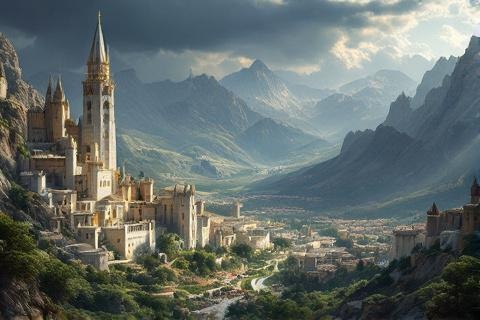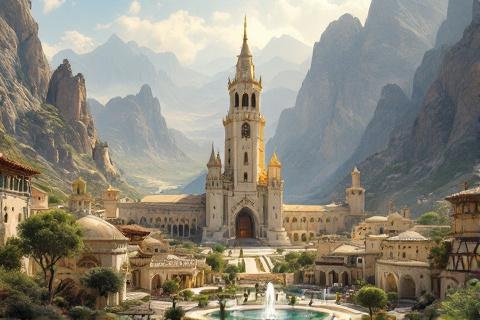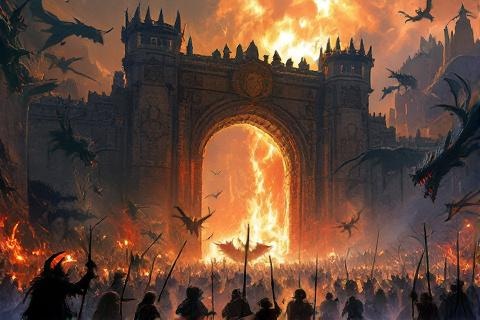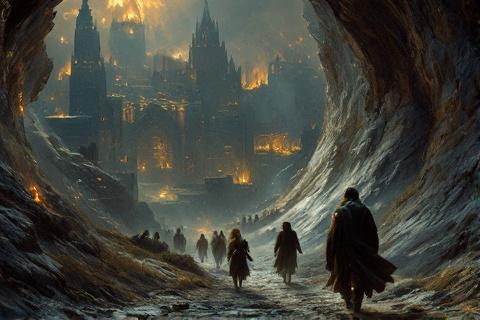
The Fall of Gondolin
A Hidden City's Last Stand
The Secret City of Turgon

In the early years of the First Age, Ulmo, the Lord of Waters,
appeared to Turgon in a dream-vision, counseling him to establish a hidden realm
that would serve as a bastion against Morgoth's growing
power. Ulmo's wisdom guided Turgon to seek a place of exceptional security,
promising that this realm would preserve the hope of both Elves
and Men in dark times to come. The Vala's foresight
would prove crucial in establishing what would become the most secret and
magnificent of all Elven realms in Middle-earth.
Following Ulmo's guidance, Turgon discovered the hidden valley of Tumladen,
nestled deep within the Encircling Mountains. The valley lay concealed in a ring
of tall peaks, accessible only through a single secret passage that wound
through the mountains. This natural fortress, located north of the forest of
Brethil, presented an ideal location for Turgon's planned city, offering both
protection and isolation from the growing threat of Morgoth in the north.
Drawing inspiration from Tirion upon Túna in
Valinor, Turgon designed Gondolin to mirror the magnificent
city of his youth. The white walls and towers of Gondolin rose high against the
mountain backdrop, built from white marble quarried from the surrounding peaks.
The city's architecture featured soaring spires, elegant arches, and beautiful
squares, all arranged around the central Tower of the King, which stood as the
highest structure in the valley.
Turgon organized the city's defenders into twelve noble houses, each with
distinct characteristics and responsibilities. The Houses of Gondolin included
the House of the King, the House of the Wing, the House of the Mole, and others,
each bearing unique colors, arms, and traditions. These houses formed the
backbone of Gondolin's military strength and social structure, with their lords
serving as both military commanders and civic leaders.
Life in the Hidden Realm
Under Turgon's rule, Gondolin flourished as a center of Noldorin culture and
craftsmanship. The city's artisans created works of unprecedented beauty, while
its scholars preserved the lore and knowledge brought from Valinor. The people
of Gondolin lived in peace and prosperity, continuing the traditions of the
Noldor while developing their own unique customs and arts,
untouched by the darkness that spread through much of Middle-earth.
To maintain the city's secrecy, Turgon established strict laws forbidding anyone
from leaving the valley or revealing its location. The king's edicts ensured
that no messages were sent out of the city, and no one who found the hidden way
was permitted to depart. These laws were enforced without exception, making
Gondolin the most secure and secret of all Elven realms in Middle-earth.
The Seven Gates of Gondolin stood as masterpieces of Noldorin engineering and
enchantment. From the outermost Gate of Wood to the final Gate of Steel, each
entrance was uniquely crafted and guarded by skilled warriors. The gates
progressed in strength and magnificence: the Gate of Stone, the Gate of Bronze,
the Gate of Writhen Iron, the Gate of Silver, and the Gate of Gold, each
protected by towers and gatehouses where vigilant guards maintained their watch
day and night.
The Coming of Tuor

Ulmo chose Tuor, a mortal man of the House of Hador, as his messenger to
Gondolin. The Lord of Waters guided Tuor through dreams and signs, providing him
with a cloak of concealment and arming him with knowledge of his crucial
mission. Ulmo's choice of Tuor reflected the Vala's continuing concern for both
Elves and Men, and his desire to prevent the complete destruction he foresaw
approaching Gondolin.
Voronwë, an Elf of Gondolin who had been saved from shipwreck by Ulmo, became
Tuor's guide through the perilous journey to the hidden city. Together they
traversed the secret way through the Encircling Mountains, facing numerous
dangers and the harsh winter weather. Their journey tested both their resolve
and the strength of their developing friendship.
Upon reaching Gondolin, Tuor appeared before King Turgon wearing the armor and
bearing the symbols given to him by Ulmo. He delivered the Vala's warning that
Gondolin's doom approached and that the city should be abandoned. Though Turgon
had once heeded Ulmo's counsel in building Gondolin, pride and love for his city
led him to reject this final warning, setting in motion the events that would
lead to the city's fall.
The Treachery of Maeglin
Maeglin, Turgon's nephew and a lord of Gondolin, was captured by Morgoth's
forces while secretly mining outside the valley in search of precious ores.
Despite his high position in Gondolin and his role as a member of the king's
council, Maeglin's desire for rare metals led him to take this fatal risk. His
capture brought the first real threat to Gondolin's security since its founding.
In the pits of Angband, Morgoth subjected Maeglin to terrible
tortures, breaking both his body and spirit. The Dark Lord recognized in Maeglin
a weakness he could exploit, perceiving the elf's secret desire for his cousin
Idril and his ambition for power within Gondolin. These desires proved to be the
key to corrupting Maeglin's loyalty.
Morgoth secured Maeglin's betrayal by promising him both Idril's hand in
marriage and rulership of Gondolin after its conquest. Maeglin revealed not only
the location of the hidden city but also detailed information about its
defenses, gates, and military organization. His intimate knowledge of Gondolin's
strengths and weaknesses provided Morgoth with the intelligence needed to plan
the city's destruction.
Morgoth's Great Army

Following Maeglin's betrayal, Morgoth began assembling the greatest host he had
yet created for a single assault. The army included thousands of orcs, wolves,
and countless other evil creatures, but its true strength lay in its mightiest
weapons: dragons and Balrogs. Morgoth committed many of his most powerful
servants to this attack, determined to crush the last independent Noldorin realm
in Beleriand.
Among the most fearsome weapons prepared for the assault were the mechanical
dragons, great metal serpents designed to breach walls and crush stone. These
machines represented the corrupt fusion of Morgoth's malice with the
technological knowledge stolen from the Noldor. Their construction remained a
closely guarded secret, adding an element of terror and surprise to the planned
assault.
The attacking forces approached Gondolin during the summer festival of Gates of
Summer, when the city's vigilance was relaxed in celebration. Moving with
unprecedented stealth for so large an army, Morgoth's forces used the
intelligence provided by Maeglin to avoid detection until they were positioned
to strike. The timing was chosen to maximize the element of surprise and catch
the defenders at their most vulnerable moment.
The Breaking of the Gates

The attack began as the sun rose on the morning of the festival, when most of
the city's inhabitants were gathered to celebrate. The first warning came too
late, as Morgoth's armies had already achieved their initial positions around
the valley. The suddenness of the assault threw the city's defense into chaos as
citizens scrambled to take up arms while dragons and Balrogs approached the
walls.
Morgoth's forces breached the Encircling Mountains using both brute force and
the secret ways revealed by Maeglin. The dragons proved particularly effective
in creating passages through the natural defenses that had protected Gondolin
for so long. The mountain walls that had kept the city hidden for centuries
became a trap, limiting escape routes for the defenders.
The Seven Gates, despite their strength and the valor of their guards, fell one
by one to the overwhelming force of Morgoth's army. Each gate's fall represented
another blow to the city's defenses, with the final Gate of Steel being breached
by the combined might of dragons, Balrogs, and the endless waves of orcs that
pressed the attack without respite.
Battle in the Streets

The Twelve Houses of Gondolin fought with legendary courage as the battle raged
through the city's streets. Each house distinguished itself in different areas
of the defense, with warriors fighting to protect their sectors of the city
against overwhelming odds. The House of the Hammer of Wrath fought in the
squares, the House of the Harp defended the walls, and the House of the Fountain
held the gates until the very end.
The most famous duel of the battle occurred when Ecthelion, Lord of the House of
the Fountain, confronted Gothmog, Lord of the Balrogs, in the Square of the
King. In this legendary encounter, Ecthelion, though mortally wounded, managed
to slay Morgoth's greatest captain by driving the spike of his helmet into the
Balrog's chest, taking his enemy with him as they both fell into the fountain.
King Turgon, after witnessing the fall of his gates and the death of many of his
lords, made his last stand in the Tower of the King. As the city burned around
him, he refused to abandon his beloved Gondolin, casting his crown at his feet
and choosing to perish with his realm.
The House of the King fought to the last soldier, protecting their lord's final
moments. The tower's fall marked the effective end of organized resistance
within the city, though pockets of defenders continued to fight throughout the
streets and squares of Gondolin.
The Secret Escape

As the city fell, Tuor took command of the surviving defenders and civilians,
organizing a desperate evacuation. His leadership provided hope and direction to
the scattered survivors, preventing complete panic as they sought escape from
the burning city. His marriage to Idril had prepared him for this role, as many
of the Gondolindrim had come to trust and respect him as their princess's
husband.
The escape route through Idril's secret tunnel proved crucial to the survival of
many Gondolindrim. Idril's foresight in constructing this hidden passage, which
led through the mountains to the north of the city, saved countless lives. The
tunnel, unknown to Maeglin, provided the only safe exit from the burning city.
During the escape, Maeglin attempted to capture Idril and her young son
Eärendil. His treachery was finally exposed when he tried to throw the child
from the walls, but Tuor confronted him in a fierce battle. The fight ended with
Maeglin being cast down from the walls of Gondolin, a fitting end for the one
who had betrayed the city to its doom.
Flight to the Mountains

The survivors faced a treacherous journey through Cirith Thoronath, the Eagles'
Cleft, a narrow pass through the mountains north of Gondolin. The passage proved
especially dangerous as Morgoth's forces pursued them, and the harsh terrain
claimed many lives. The refugees endured bitter cold and treacherous footing as
they made their way through the mountain pass.
The most celebrated act of heroism during the escape occurred when
Glorfindel, Lord of the House of the Golden Flower,
sacrificed himself fighting a Balrog that ambushed the refugees. The battle on
the narrow cliff path ended with both Glorfindel and the Balrog plunging into
the abyss, but his sacrifice allowed the other survivors to escape. The Eagles
of Manwë recovered his body, which was buried with honor along the escape route.
The remaining survivors, led by Tuor and Idril, eventually reached safety at the
Mouths of Sirion. The journey was long and fraught with danger, but the
protection of the Eagles of Manwë helped ensure that some of Gondolin's people
survived to carry on its legacy. The refugees joined other survivors of the
great Elven realms that had fallen to Morgoth's forces.
Legacy of the Fall
The fall of Gondolin represented one of the most significant defeats in the war
against Morgoth, marking the loss of the last hidden realm of the Noldor in
Middle-earth. The destruction of this powerful Elven stronghold shifted the
balance of power decisively in Morgoth's favor, though the survival of key
individuals would ultimately contribute to his downfall. The loss of Gondolin's
military strength and its role as a haven for the Elves dealt a severe blow to
the resistance against the Dark Lord.
The survivors of Gondolin, particularly Eärendil, played crucial roles in the
events that followed. Eärendil's later journey to Valinor, carrying a
Silmaril and pleading for the Valar's intervention, was
influenced by the stories and traditions he learned as a child in Gondolin. His
success in this mission led directly to the War of Wrath
and Morgoth's final defeat.
Though the city was destroyed, the cultural legacy of Gondolin survived through
its refugees. The knowledge, crafts, and traditions preserved by the survivors
influenced both the Second and Third Ages of Middle-earth. The tales of
Gondolin's splendor and tragedy became legendary among both Elves and Men,
serving as a reminder of both the heights of achievement possible in
Middle-earth and the ever-present threat of evil.
